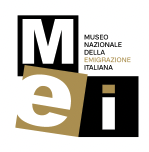History of MEI
On the 3rd of December 2008, the Ministry of Foreign Affairs and International Cooperation established the “Museo Nazionale dell'Emigrazione Italiana” (National Museum of Italian Emigration) as a permanent structure of the Ministry. The creation of the new museum is curated in agreement with the Ministry of Culture, with the task of acquiring, cataloguing, preserving, ordering and exhibiting cultural assets for the purpose of education and study of Italian emigration.
The former gipsoteca (plaster cast gallery) of the Vittoriano monumental complex, in Piazza Venezia in Rome, was established as the provisional head office of the MEI. The museum was inaugurated in 2009, thanks to partnerships with numerous research organisations, museums and archives, through loans of photographs and documents, bearing witness to Italian migratory movements over the decades.
In March 2016, the temporary location of the Vittoriano was decommissioned and procedures were launched to identify a new and permanent home for the Mei. In 2018, Genoa and the Commenda di San Giovanni di Prè were chosen to host the new Museo Nazionale dell'Emigrazione Italiana.
In May 2022, after four years of scientific research and more than two years of planning and restoration, the MEI opened its doors to the public, with an itinerary developed on three floors divided into 16 areas, offering visitors the chance to retrace the many stories of Italian emigration, from the Unification of Italy (and even before) to the present day.
The Museum tells visitors the stories of the lives of the protagonists of emigration, framed within a historiographical framework. Individual experiences are presented to the public through original sources such as autobiographies, diaries, letters, photographs and newspapers, digitised and re-elaborated thanks to multimedia stations, immersive installations and theatrical reconstructions.
The study and research work carried out involved the collaboration of scholars and various organisations, research institutes, archives, museums and international centres, as well as museums in Italy that have been focused on migratory issues from a regional perspective for years.
The contribution of the Associations of Italian citizens abroad and international Italian communities was also essential, as they enthusiastically contributed to increasing the wealth of stories presented in the exhibition. And this is what makes the museum a constantly evolving and expanding participatory museum.

